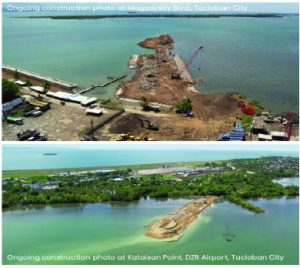TACLOBAN CITY – The regional office of the Department of Public Works and Highways (DPWH) announced through the ‘Kapihan sa Barong Pilipinas’ program that the causeway project in this city is now underway and is expected to be completed by 2025 and onwards.
The causeway project is primarily a storm surge protection structure designed to withstand disasters and high humidity, offering protection to nearby communities.
Its alignment starts at Magsaysay Boulevard and ends at Kataisan Point in Brgy. San Jose and includes a navigational opening sufficient for boat traffic and waterways that allow the continuous flow of seawater.
According to Engr. Edgar Tabacon, the DPWH regional director, the project has an allocation of P4.5 billion and involves the construction of a 4-lane road embankment approximately 2.566 kilometers in length, which includes separate bike lanes, concrete canals, sidewalks, and wave deflectors on both sides.
To ensure the continuous flow of seawater, the structure includes five reinforced concrete box culverts and a bridge spanning 360 meters, extended from the initially planned 180 meters based on the recommendation by the city council.
The total project cost is P4.586 billion, with a total released amount of P880 million (2022 & 2024 General Appropriations Act).
The project schedule is from February 2023 to January 2025 and onwards. Currently, the project has a 5.16% completion based on the total project cost.
The project, also serving as an alternate route for the traveling public, aims to reduce travel time from Tacloban City proper to the Daniel Z. Romualdez Airport and decongest traffic along the existing thoroughfare.
Once completed, the usual travel time of 45 minutes from the city proper to DZR Airport will be reduced to just 10 minutes.
This reduction in travel time will result in cheaper logistics costs, faster financial returns, easier access to essential goods and services, and a more affordable and safer travel experience in Leyte’s capital city and the entire Eastern Visayas region, Tabacon said.
(LIZBETH ANN A. ABELLA)




